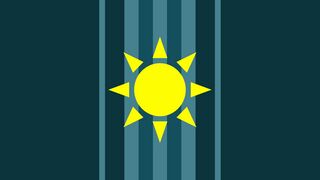New Altnavia (Pacifica)
New Altnavia, officially The Democratic Republic of New Altnavia (Pur Ramaedtra Velisia lo Alisi Altineivio) is a unitary state located in northern Bailtem. It is bordered to the east by Andrendia, to the south by Amberholde, Kustannuksa, Dacian Federation and to the west by People’s Republic of San Marsico. The nation’s current leaders are President Christopher Semili Ideipi and Prime Minister James Caliderei Pelidi. The capital and largest city of the nation is Noveopolis.
The Democratic Republic of New Altnavia | |
|---|---|
|
Flag | |
Motto: Together as one, we build a path to the better ‘neivio’ (peaceful seaside) | |
Anthem: The Light Over The East Horizon | |
| Capital | Noveopolis |
| Official languages | Pacicayan, Silivian and Austral |
| Ethnic groups | Pacicayan 55.2%
Silivian 29.8% Nealti 10.1% Other 4.9% |
| Government | |
• President | Christopher Semili Ideipi |
• Prime Minister | James Caliderei Pelidi |
| Area | |
• Total | 270,328 km2 (104,374 sq mi) |
| Population | |
• Census | 53,408,900 (2023.07) (18) |
• Density | 198/km2 (512.8/sq mi) |
| Currency | Viliceide (VCD) |
| Time zone | UTC +2 |
| Date format | YYYY/MM/DD |
| Driving side | right |
| Calling code | +174 |
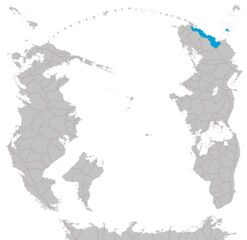 | |
The nation consists of 8 provinces on the mainland of the continent Bailtem and three islands. Most of the nation has a tropical climate. The current republic was founded in September 2022, a month after the former King Laleikiya (1911~2022) passed away with no successors. New Altnavia has a population of 53.4 million, making it the 16th most populous nation in the South Pacific. The official languages of New Altnavia are Pacicayan, Silivian and Austral with Pacicayan being the most well-known language throughout the nation. 95.1% of the people of the nation are from the three main ethnic groups, which are Pacicayan, Silivian and Nealti.

The Pacicayan people are native to the modern-day Sudu Capitalia, Greater Noveopolis, Ineopbi (pronounced ee-nay-yo-bee), Hurudeifa, Fipotalla and North Fipotalla. The Silivians are native to Nodeiso, Silivo and Viruidi Island while the Nealti are native to the region called New East Altnavia.
Etymology
The name ‘New Altnavia’ comes from the kingdom’s name that existed until 2022, which had the same territory as the current republic, called Altineivio Kingdom. In the name ‘Altineivio’, ‘alti’ means ‘beautiful’ in Silivian and ‘neivio’ means ‘peaceful seaside’ in Pacicayan.
History
Prehistory
Exactly when the first humans settled in the modern-day mainland New Altnavia is unknown. It is thought that the event happened 90-150 thousand years ago. The oldest artifacts were discovered along the Pacicaya River, Fipotalla River and Silivo River. Humans gathered to make small towns consisting of about 120 people on average. The small towns traded and fought with one another. These towns are not considered nations as they had a small number of people and didn’t have a proper government.
Early Bronze Age States (1887 BCE ~ 1610 BCE)
The ‘Early Bronze Age States’ refers to the nations that existed between 1887 BCE, when Decidilia was founded, and 1610 BCE, when the Great Deforestation ended.
The First Kingdoms
In the 1900s BCE, towns along the Pacicayan River started to either unite with each other or invade and annex one another. The Kingdom of Decidilia is said to have been founded along the Pacicayan River in 1887 BCE.
At similar times, similar things happened along the river banks of Silivo and Fipotalla. The Kingdom of Luxideis was founded along the Fipotalla River in 1863 BCE and the Kingdom of Servipilo was founded along the Silivo River in 1824 BCE. The three kingdoms continued to extend their borders, annexing small settlements around them.
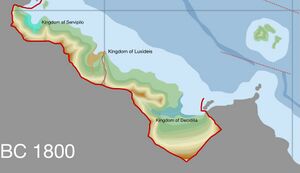
By 1800 BCE, the kingdoms had over 90% of the total population in mainland New Altnavia. They developed cultures, including their own scripts and architecture styles. The land between the nations was mostly taken up by dense rainforests and the forests blocked the kingdoms from extending their territory a lot. Moving through the forests was not easy. However, the kingdoms often traded with and helped one another in many ways and managed to have peaceful relations for several centuries. These few centuries are known as the most peaceful times in all of New Altnavian history.
The Great Deforestation and Territory Extension
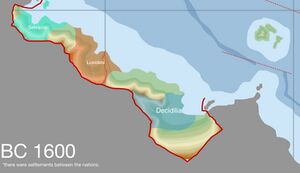
The three ancient kingdoms, Decidilia, Luxideis and Servipilo, grew a lot in population as small tribes between the kingdoms joined them and better farming methods were developed. The most populous, Decidilia is thought to have had over 120 thousand people, which is a lot considering the climate and size of the kingdom. Because of the growing population, more land was needed but the nations were surrounded by the ocean and rainforests. In 1730s BCE, mass deforestation started in modern day Ineopbi by Decidilians. This spread to other regions and other kingdoms and an incredible amount of trees were taken down. This event ended around 1610 BCE, and the kingdoms had grown by an immense amount.
Enneidi Era (1610 BCE ~ 1044 BCE)
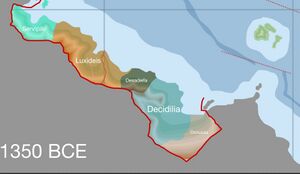
The Enneidi Era began as the Great Deforestation ended. Small deforestation events continued to happen. New nations, known as the Second Generation Bronze Age States were founded.
By 1350 BCE, the nations had control of all the current New Altnavian territory except for Nealta. The five states had peaceful relations for the first two centuries, but started to have wars with one another.
Desadeifa (1542 BCE ~ 1086 BCE)
Desadeifa was founded in modern day Hurudeifa in 1542 BCE by some tribes that lived in the region. At first, it was ruled by a king. However, in 1404 BCE, the king was overthrown and the first republic in the history of New Altnavia was founded. However, there are historians that claim that there was no republic and a new king ruled the nation.
The so-called republic fell in 1383 BCE, and Desadeifa became a kingdom again. Since about then, it had good relations with Decidilia. The two nations helped each other until 1102 BCE, when King Helideira became the king of Decidilia. He did not attack Desadeifa, but refused to continue the good relationship between the nations.
Desadeifa was invaded and conquered by the Kingdom of Luxideis in 1086 BCE.
Donuicia (1563 BCE ~ 1242 BCE)
Donuicia was founded in modern day Sudu Capitalia in 1563 BCE by local tribes and some Decidilians that were tired of the life in Decidilia. The nation grew quickly, absorbing nearby tribes. It didn’t have good relations with Decidilia, but Donuicia managed to block Decidilia from annexing the nation in the wars between the two nations, which let Donuicia stay independent for a long time. Donuicia at last fell to Decidilian forces in 1242 BCE.
The Great Enneidi Wars (1067 BCE ~ 1044 BCE)
By 1086 BCE, only the original three kingdoms (Servipilo, Luxideis and Decidilia) existed. Desadeifa had been annexed by Luxideis and Donuicia had been annexed by Decidilia.
Relations between Servipilo and Luxideis were very bad. In the summer of 1067 BCE, Luxideis forces crossed the nation’s northern borders and invaded Servipilo. This event marked the start of the Great Enneidi Wars, which refer to the three wars that happened in the next 23 years.
For the first few months, Servipilo managed to block the massive army of Luxideis from taking its major cities. However, as time passed it grew harder and harder. At last, Servipilo asked Decidilia for help in 1066 BCE.
Decidilian forces invaded the southern part of Luxideis in 1065 BCE. Luxideis, which had most of its forces in the north, lost a lot of land in the south. Servipilo successfully had its first major victory in the war and started to reclaim the land it had lost. With Servipilo and Decidilia attacking at the same time, Luxideis grew weaker and requested a peace treaty in 1062 BCE. The treaty made Luxideis lose a lot of land to its two enemies.
Luxideis soon rebuilt its military. In the autumn of 1055 BCE, Luxideis invaded Decidilia to take control of the territory it had lost. During the first few weeks, Decidilia lost several times, letting Luxideis forces reach a town that was only 30 kilometers away from the Decidilian capital located in modern day Noveopolis. But Luxideis failed to continue, and Decidilian forces pushed Luxideis back to the north. Servipilo also invaded Luxideis in 1053 BCE, and Luxideis grew smaller and weaker. In the spring of 1052 BCE, the capital of Luxideis located in modern day Fipitelepolis was taken over by Decidilian and Servipilian forces and the King of Luxideis surrendered. Decidilia annexed Luxideis territory in the south of the Fipotalla River while Servipilo annexed the northern part. However, some government officials of Servipilo did not accept the border.
In 1047 BCE, the ‘Third Enneidi War’ started as Servipilo forces invaded Decidilia at night. Decidilia, which thought of Servipilo as an ally had not prepared for a war and lost in several wars. Servipilo took control of the entire modern day Fipotalla and started to attack Hurudeifa. But just two months after the start of the war, Decidilia started to win and Servipilo retreated to the north. The war went on for three years and ended in early 1044 BCE as Decidilian forces entered the Servipilian capital. Decidilia had united the mainland New Altnavia for the first time in history, but it only lasted for 7 months. Several rebels started to attack the government in late 1044 BCE, marking the end of the Enneidi Era.
